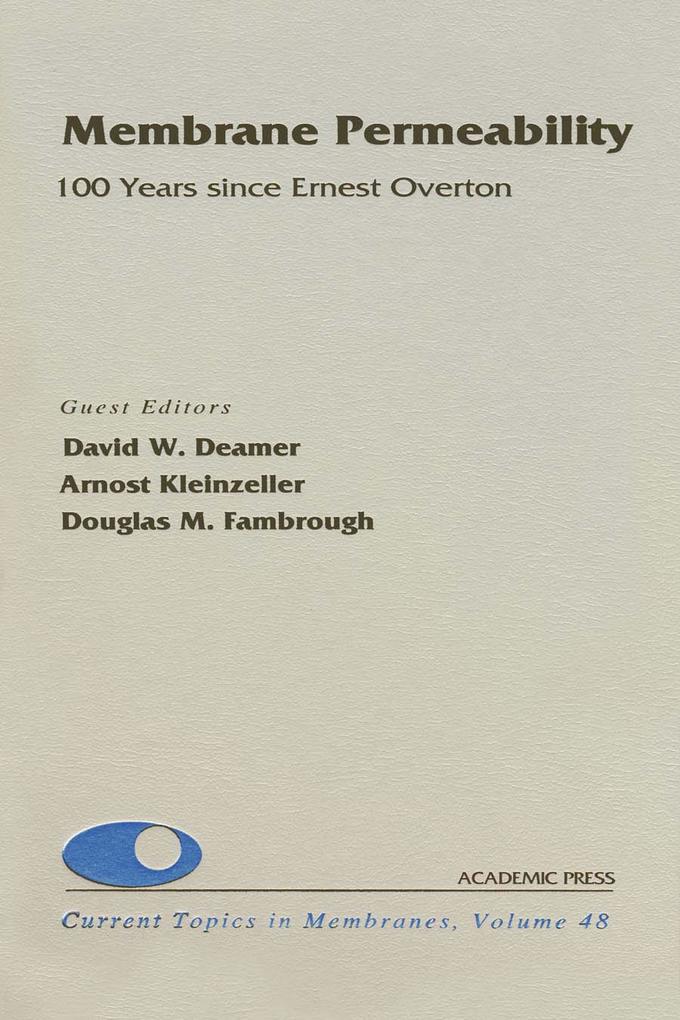Membrane permeability is fundamental to all cell biology and subcellular biology. The cell exists as a closed unit. Import and export depend upon a number of sophisticated mechanisms, such as active transport, endocytosis, exocytosis, and passive diffusion. These systems are critical for the normal housekeeping physiological functions. However, access to the cell is also taken advantage of by toxic microbes (such as cholera or ptomaine) and when designing drugs.
Ernest Overton, one of the pioneers in lipid membrane research, put forward the first comprehensive theory of lipid membrane structure. His most quoted paper on the osmotic properties of cells laid the foundation for the modern concepts of membrane function, most notably important in anesthesia.
This book is designed to celebrate the centennial anniversary (in the first chapter) of Overton's work. Subsequent chapters present readers with up-to-date concepts of membrane structure and function and the challenge they pose for new explorations.
- Provides an historical perspective of Overton's contributions to the theory of narcosis
- Presents an overview of each permeability mechanism, including active transport, endocytosis, exocytosis, and passive diffusion
Inhaltsverzeichnis
1;Front Cover ;1 2;Membrane Permeability: 100 Years since Ernest Overton;4 3;Copyright Page;5 4;Contents;6 5;Contributors;10 6;Tribute;12 7;Previous Volumes in Series;18 8;Chapter 1. Charles Ernest Overtons Concept of a Cell Membrane;20 8.1;I. A Brief Biography of Ernest Overton;20 8.2;II. The Exchange of Solutes across the Cell Boundary;21 8.3;III. MeyerOverton Theory of Narcosis;30 8.4;IV. Role of Cations in the Excitability Process;32 8.5;V. Overtons Scientific Personality;36 8.6;References;37 9;Chapter 2. Structure and Physical Properties of the Lipid Membrane;42 9.1;I. Bilayers in Biological Membranes;42 9.2;II. Phase Behavior of Membrane Phospholipids;44 9.3;III. Structure of Phospholipid Bilayers;47 9.4;IV. Stability and Mechanical Properties of Bilayers;50 9.5;V. Interbilayer Interactions;51 9.6;VI. Roles of Specific Lipids in Membrane Bilayers;53 9.7;VII. Summary;56 9.8;References;56 10;Chapter 3. Insights from Computer Simulations into the Interactions of Small Molecules with Lipid Bilayers;68 10.1;I. Introduction;68 10.2;II. Methods of Simulation;71 10.3;III. Distribution of Solutes in a Bilayer;76 10.4;IV. Membrane Permeability of Small Molecules;88 10.5;V. Summary;91 10.6;References;92 11;Chapter 4. Membrane Permeability Barriers to Ionic and Polar Solutes;96 11.1;I. Introduction;96 11.2;II. Overtons Concept of Membrane Permeability;97 11.3;III. Permeation by the Solubility-Diffusion Mechanism;98 11.4;IV. Permeation through Transient Pores;107 11.5;V. Proton Permeation;111 11.6;VI. Summary;112 11.7;References;113 12;Chapter 5. Water Permeation across Membranes;116 12.1;I. Introduction;116 12.2;II. Biophysics of Water Transport;117 12.3;III. Water Transport across Lipid Membranes;125 12.4;IV. Water Transport across Biological Membranes: Water Channels;126 12.5;V. Summary;134 12.6;References;135 13;Chapter 6. Membrane Events Involved in Volume Regulation;142 13.1;I. Introduction: Biological Role;143 13.2;II. Membrane Transport Mechanisms in Regulatory Vol
ume Decrease (RVD);145 13.3;III. Membrane Transport Systems Involved in Volume Regulatory Increase (RVI);154 13.4;IV. Volume Sensing and Signal Transduction;159 13.5;V. Cytoskeleton and Cell Volume Regulation;176 13.6;VI. Summary;190 13.7; References;191 14;Chapter 7. Interaction of Natural and Model Peptides with Membranes;216 14.1;I. Introduction;216 14.2;II. Free Energy of Peptide Binding to Membranes;217 14.3;III. Factors Influencing Peptide Structure and Orientation in Membranes;231 14.4;IV. Summary;239 14.5; References ;239 15;Chapter 8. Lateral Diffusion of Lipids and Proteins;248 15.1;I. Introduction;248 15.2;II. The Key Question;252 15.3;III. Theoretical Developments;253 15.4;IV. Factors Controlling Lateral Diffusion;263 15.5;V. Applications to Membranes;275 15.6;VI. Summary;285 15.7;References;287 16;Chapter 9. A Short History of Ion Channels and Signal Propagation;302 16.1;I. Introduction;302 16.2;II. Ionic Currents in Axons;303 16.3;III. Carriers, Pores, Gates, and Selectivity before Cloning;306 16.4;IV. The Age of Cloning;315 16.5;V. Summary;325 16.6;References;326 17;Chapter 10. Lipid Membrane and Ligand-Gated Ion Channels in General Anesthetic Action;330 17.1;I. Introduction;330 17.2;II. The MeyerOverton Hypothesis and the Evolution of Lipid-Based Theories of Anesthesia;332 17.3;III. The Rise of Protein-Based Theories of Anesthetic Action;341 17.4;IV. Future Directions;356 17.5;V. Summary;361 17.6; References;363 18;Chapter 11. Plasma Membrane-Localized Signal Transduction;370 18.1;I. Introduction;370 18.2;II. Membrane Receptor-Mediated Signaling: Biochemical Mechanisms;372 18.3;III. Signal Amplification;397 18.4;IV. The Plasma Membrane as an Integration Site for Signal Transduction;400 18.5;V. Summary;405 18.6; References;405 19;Chapter 12. Active Transport and Pumps;416 19.1;I. Introduction;416 19.2;II. Pumps;420 19.3;III. Summary;432 19.4;References;433 20;Index;438





























